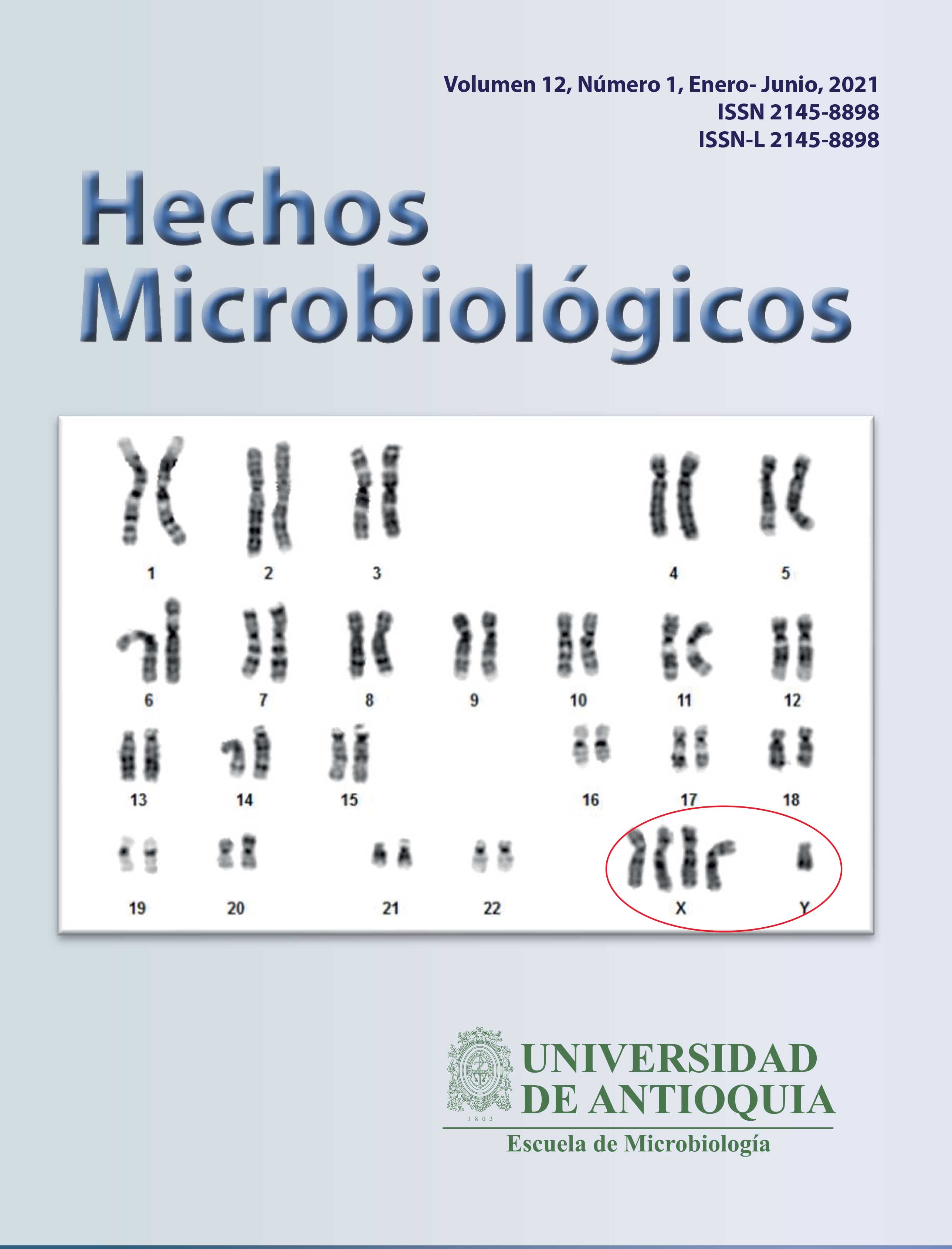Detection of intracellular toxins A and B in epidemic genotypes of Clostridiodes difficile
DOI:
https://doi.org/10.17533/10.17533/udea.hm.v12n1a02Keywords:
Clostridioides difficile, toxins, intracellular, NAP1/RT027Abstract
Introduction: Clostridioides difficile is the world’s leading cause of hospital-acquired diarrhea due to antibiotic use, with toxins A and B (TcdA and TcdB) as the main virulence factors. In recent years, there has been an emergence of strains with increased virulence, characterized as genotype NAP1/RT027, which are responsible for epidemic outbreaks. These strains exhibit a higher toxin secretion and high fluoroquinolone resistance. The first report of epidemic outbreaks due to these strains in Latin America was described in Costa Rica, where an autochthonous genotype was also described and classified as NAPCR1/RT019. This genotype showed increased virulence but no toxin oversecretion.
Methods: Cell lysates from clinical isolates of NAP1/ RT027, NAPCR1/RT019, and NAP4/RT014 genotypes were obtained and intracellular TcdA and TcdB were detected by Western Blot (WB). In addition, a cell culture cytotoxicity assay was performed to evaluate the level and biological activity of TcdB in those lysates. This was performed at different times on the in vitro bacterial growth.
Results: TcdA was detected in the cell lysates of all study genotypes and TcdB was detected only in NAP1/RT027 by WB. The highest TcdA and TcdB signal was detected in NAP1/RT027 at 24 and 48 hours of growth. On cell culture, the predominant cytotoxic activity was due to TcdB produced by NAP1/RT027, followed by NAPCR1/RT019 and a lower activity in NAP4/RT014.
Conclusions: The detection of a higher amount and activity of intracellular toxins in the epidemic strain NAP1/RT027 correlates with previous reports of toxin overproduction by this genotype. It was proved that a strain with increased virulence, such as NAPCR1/RT019 does not overproduce toxins. This also correlates with reports of extracellular toxin detection. This study presents important information about methodologies for toxin detection on C. difficile lysates and contributes to the discussion on the differences in toxin production according to this pathogen’s genotypes.
Downloads
References
Slimings C, Riley T. Antibiotics and hospital-acquired Clostridium difficile infection: Update of systematic review and meta-analysis. J Antimicrob Chemother. 2014;69:881–891.
Voth D, Ballard J. Clostridium difficile toxins: mechanism of action and role in disease. Clin Microbiol Rev. 2005;18:247–263.
Hundsberger T, Braun V, Weidmann M, Leukel P, Sauerborn M, von Eichel-Streiber C. Transcription analysis of the genes tcdA-E of the pathogenicity locus of Clostridium difficile. Eur J Biochem. 1997;244:735– 742.
Matamouros S, England P, Dupuy B. Clostridium difficile toxin expression is inhibited by the novel regulator TcdC. Mol Microbil. 2007;64(5):1274-1288.
Cartman ST, Kelly ML, Heeg D, Heap J, Minton N. Precise manipulation of the Clostridium difficile chromosome reveals a lack of association between the tcdC genotype and toxin production. Appl Environ Microbiol. 2012;78:4683–4690.
Vedantam G, Clark A, Chu M, McQuade R, Mallozzi M, Viswanathan VK. Clostridium difficile infection: toxins and non-toxin virulence factors, and their contributions to disease establishment and host response. Gut Microbes. 2012;121e134.
Søes L, Holt H, Böttiger B, Nielsen H, Andreasen V, Kemp M, et al. Risk factors for Clostridium difficile infection in the community: a case-control study in patients in general practice, Denmark, 2009-2011. Epidemiol Infect. 2013;2:27,1–12.
Cartman S, Heap J, Kuehne S, Cockayne A, Minton NP. The emergence of “hypervirulence” in Clostridium difficile. Int J Med Microbiol. 2010;300:387e395
Warny M, Pepin J, Fang A, Killgore G, Thompson A, et al. Toxin production by an emerging strain of Clostridium difficile associated with outbreaks of severe disease in North America and Europe. Lancet. 2005;366: 1079e1084.
Collins D, Hawkey P, Riley T. Epidemiology of Clostridium difficile infection in Asia. Antimicrob Resist Infect Control. 2013;2:21.
McDonald C, Killgore G, Thompson A, Owens R, Kazakova S, Sambol S, et al. An epidemic, toxin gene- variant strain of Clostridium difficile. N Engl J Med. 2005;353:2433e2441,
Quesada-Gómez C, Rodríguez C, Gamboa-Coronado M, Rodríguez-Cavallini E, Du T, Mulvey MR, et al. Emergence of Clostridium difficile NAP1 in Latin America. J Clin Microbiol. 2010;48:669–670.
Merrigan M, Venugopal A, Mallozzi M, Roxas B, Viswanathan V, Johson S, et al. Human hypervirulent Clostridium difficile strains exhibit increased sporulation as well as robust toxin production. J Bacteriol. 2010;192:4904–4911
Quesada-Gómez C, López-Ureña D, Acuña-Amador L, Villalobos Zúñiga M, Du T, Freire R, et al. Emergence of an outbreak-associated Clostridium difficile variant with increased virulence. J Clin Microbiol. 2015;53:1216–1226
Govind R, Dupuy B. Secretion of Clostridium difficile toxins A and B requires the holin-like protein TcdE. PLoS Pathogens. 2012;8(6), 1–14.
Lyras D, O’Connor JR, Howarth PM, Sambol SP, Carter GP, Phumoonna T, et al. Toxin B is essential for virulence of Clostridium difficile. Nature. 2009;458(7242):1176–9.
Murray R, Boyd D, Levett PN, Mulvey MR, Alfa MJ. Truncation in the tcdC region of the Clostridium difficile PathLoc of clinical isolates does not predict increased biological activity of Toxin B or Toxin A. BMC Infectious Diseases. 2009;9:103.
Dupuy B, Govind R, Antunes A, Matamouros S. Clostridium difficile toxin synthesis is negatively regulated by TcdC. Journal of Medical Microbiology. 2008;57:685–689.
Quesada-Gómez C, López-Ureña D, Chumbler N, Kroh HK, Castro-Peña C, Rodríguez C, et al. Analysis of TcdB proteins within the hypervirulent clade 2 reveals an impact of RhoA glucosylation on Clostridium difficile proinflammatory activities. Infect Immun. 2016;84:856–865.
Hundsberger T, Braun V, Weidmann M, Leukel P, Sauerborn M, von Eichel-Streiber C. Transcription analysis of the genes tcdA–E of the pathogenicity locus of Clostridium difficile. Eur J Biochem. 1997;244:735– 742.
Govind R, Fitzwater L, Nichols R. Observations on the role of TcdE isoforms in Clostridium difficile toxin secretion. J Bacteriol. 2015;197:2600–2609








